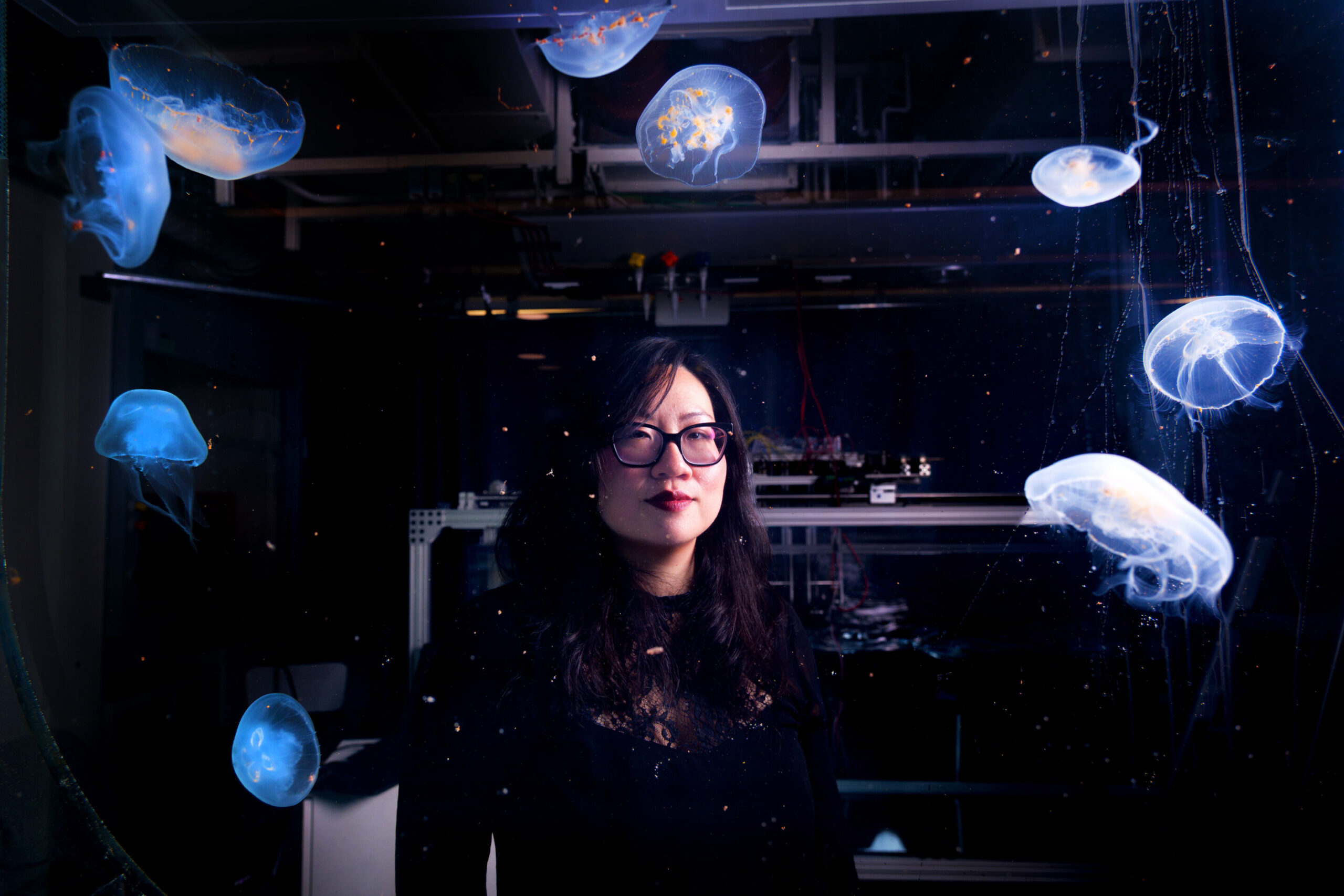
University of Colorado Bounder Engineer Nicole Xu Stands Behind the main jellyfish tank in her lab. Glenn Asakawa/University of Colorado Bounder
In a towering aquarium in a darkened laboratory, Moon jellyfish (aurelia aurita) hover as if floating in space. The glow of neon lights illuminates their translucent, bell-shaped bodies as they expand and contrast rhythmically, their graceful tenacles flowing in wavelike patterns.
Cu Boulder Engineer Nicole Xu Watches Them With Fondness. Xu, an assistant professor in the paul M. Rady Department of Mechanical Engineering, First Became Fascinated with Moon Jellies More Than Ana a decade ago before, their extraordinary swimming.
Today, Xu has developed a way to harness their efficiency and ease at moving through the water in ways that could make someone make some types of aquatic reserchuch Easier.
She fits the jellies with microelectronic devices that activate key swimming muscles, enabling results to steer them toward remote ocean areas that are hard to access in any other way. Eventually, She plans to add sensors to the devices that can gather critical data on temperature, Ph and other environmental characteristics.
“Think of our device like a pacemaker on the heart,” xu said. “We’re stimulating the swim muscle by causing contractions and turning the animals towards a certain direct.”
Going where humans can’t go
As Climate Change Accelerates, Ocean Waters are due to a variety of marine life. The Ocean is Getting Warmer and more acidic as it absorbs growing Amounts of Atmospheric Carbon Dioxide.

Nicole xu reaches her hand into the tank and touches one of the moon jellyfish. Credit: Glenn Asakawa/University of Colorado Bounder
Measuring changes in the ocean is essential to understand how human activities are impacting all life on Earth. But because the ocean is so vast and deep, some parts are hard to study without prohibitively expensive equipment. The cyberg jellies could offer a way for humans to wade into these relatively uncharted watters.
Moon jellyfish are the most energy-efficient animals on the plan. They’re prehistoric, with a simple body structure that has styed the same for more than 500 million years. As invertebrates, they also lacked a brain or spinal cord, thought they do have basic organs and a pair of overlapping nerve nets. Importantly, the jellies do not have nociceptors, or sensory receptors that can detect potentially harmful stimuli.
Moon jellies can range from a centimeter to more than a foot in diameter. Their short, fin tenacles help them sting and catch prey like Zooplankton, Crustacean Larvae and Small Fish. But Thankfully for Xu, Their Sting Cells Can’t Penetrate Human Skin.
Thought themre often found Near Coastlines, Close to their favorite food sources, moon jellies live in diverse habitats worldwide and can swim to increase On Earth, Including the Mariana Trench, which sits rooughly 36,000 Feet Beneath The Western Pacific Ocean’s Surface at Its Deepest Point.
Xu co-created the biohybrid robotic jellyfish concept with her former academic advisor about five years ago, and she first Tested them in the field in 2020, Steering them Around Shallow Ocean Watters off the Coast of Woods Hole, Mass.
On top of the implications for Ocean and Climate Research, Xu Believes We Can Draw Inspiration from the Jellyfish.
“There’s really somewithing special about the way moon jellies swim.

From Left: Nicole Xu and Graduate Students Marshall Graybill and Charlie Fraga Stand Next to the main jellyfish tank in xu’s lab. Credit: Glenn Asakawa/University of Colorado Bounder
Striving for Ethical Research
Today, Xu Spends Much of Her Time Studying Precise
XU, Research Associate Yunxing Su and Graduate Student Mija Jovska Published a new study in Physical review fluids That involved adding biodegradable particles to a jellyfish tank. The researchers then shone a laser through the tank to illuminate the suspended particles in the water and visualize how water flows when jellies swim.
In the past, resarchers have used synthetic tracers Could be more sustainable, more affordable and less toxic alternatives.
She and Graduate Student Charlie Fraga Are Also Working on Making The Jellyfish Easier to Steer in the Wild. Going forward, xu hopes to design other natural-inspired tools for study the Ocean.
There’s more to learn about the ethics of study invertebrates. In a Bioinspiration & Biomimetics Paper Published earlier in 2025Xu and others pointed out the need for more investigation of how research affects invertebrates. It was once widely believed that invertebrates couldn’t feel pain, but there is growing evidence that some do react to aversive stimuli.
Through all of her research, xu says she strives to minimize harm to the animals she works with. When they’re stressed, Moon Jellies May Secrete Extra Mucus, and they often stop reproducing. But Xu’s Jellies Have Not Shown Increased Mucus Production, and Small Polyps – Baby jellyfish the size of a pinhead with teencles are just beginning to form – Line the Inside of Xufish Tanx.
“It’s our Responsibility as Researchers to Think About These Ethical Considerations Up Front,” Xu said. “But as far as we can tell, the jellyfish are doing well. They’re thriving.”
More information:
Yunxing su al, biodegradable tracer particles for underwater participle image velocimetry, Physical review fluids (2025). Doi: 10.1103/BG66-976x
Nicole w xu et al, ethics of biohybrid robotics and invertebrate research: biohybrid robotic jellyfish as a case study, Bioinspiration & Biomimetics (2025). Doi: 10.1088/1748-3190/ADC0D4
Citation: ‘Cyberg jellyfish’ could aid in deep-sea research, inspire next-gene underwater vehicles (2025, August 21) Retrieved 21 August 2025 from Retrieved 21 August 2025 from https://techxplore.com/news/2025-08-yborg- jellyfish-eid- deep-esa.html
This document is Subject to copyright. Apart from any Fair Dealing for the purpose of private study or research, no part may be reproduced without the written permission. The content is provided for information purposes only.


